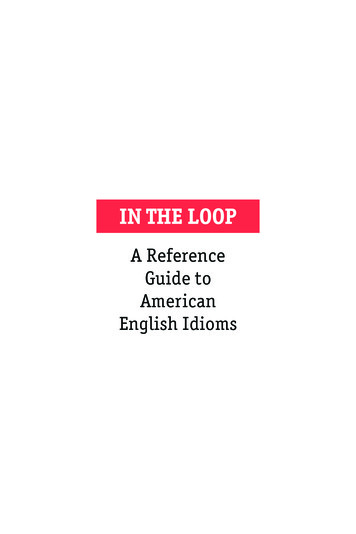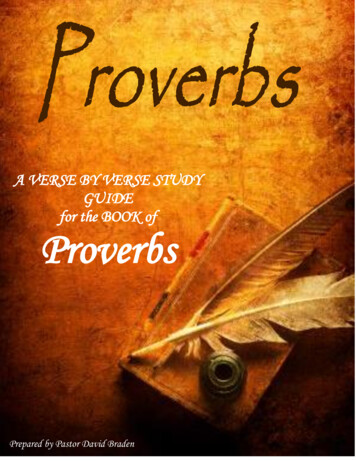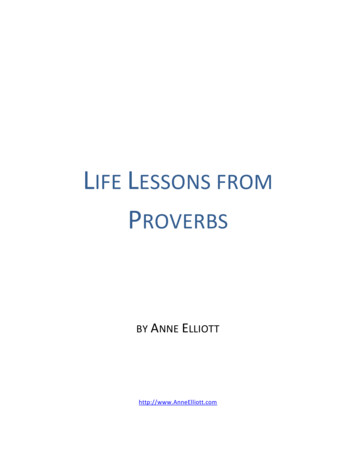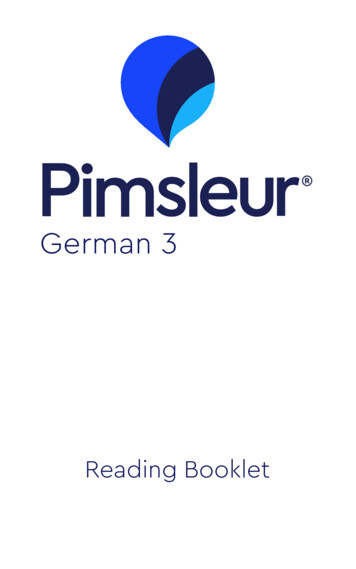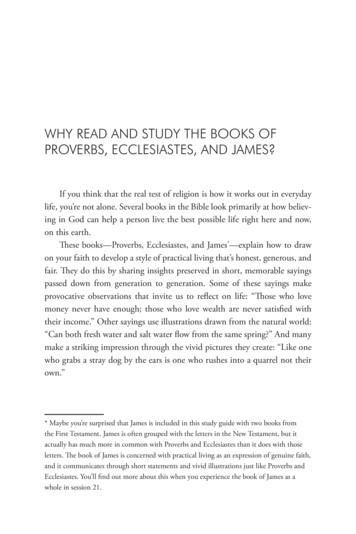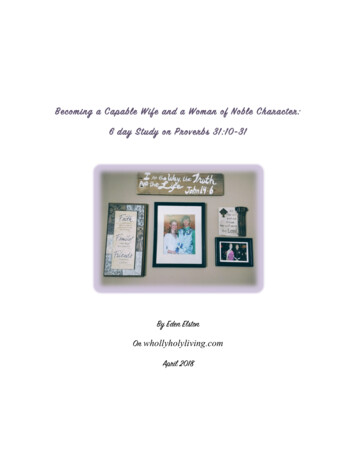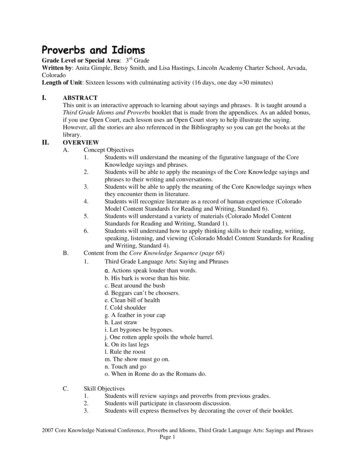
Transcription
Proverbs and IdiomsGrade Level or Special Area: 3rd GradeWritten by: Anita Gimple, Betsy Smith, and Lisa Hastings, Lincoln Academy Charter School, Arvada,ColoradoLength of Unit: Sixteen lessons with culminating activity (16 days, one day 30 minutes)I.II.ABSTRACTThis unit is an interactive approach to learning about sayings and phrases. It is taught around aThird Grade Idioms and Proverbs booklet that is made from the appendices. As an added bonus,if you use Open Court, each lesson uses an Open Court story to help illustrate the saying.However, all the stories are also referenced in the Bibliography so you can get the books at thelibrary.OVERVIEWA.Concept Objectives1.Students will understand the meaning of the figurative language of the CoreKnowledge sayings and phrases.2.Students will be able to apply the meanings of the Core Knowledge sayings andphrases to their writing and conversations.3.Students will be able to apply the meaning of the Core Knowledge sayings whenthey encounter them in literature.4.Students will recognize literature as a record of human experience (ColoradoModel Content Standards for Reading and Writing, Standard 6).5.Students will understand a variety of materials (Colorado Model ContentStandards for Reading and Writing, Standard 1).6.Students will understand how to apply thinking skills to their reading, writing,speaking, listening, and viewing (Colorado Model Content Standards for Readingand Writing, Standard 4).B.Content from the Core Knowledge Sequence (page 68)1.Third Grade Language Arts: Saying and Phrasesa. Actions speak louder than words.b. His bark is worse than his bite.c. Beat around the bushd. Beggars can’t be choosers.e. Clean bill of healthf. Cold shoulderg. A feather in your caph. Last strawi. Let bygones be bygones.j. One rotten apple spoils the whole barrel.k. On its last legsl. Rule the roostm. The show must go on.n. Touch and goo. When in Rome do as the Romans do.C.Skill Objectives1.Students will review sayings and proverbs from previous grades.2.Students will participate in classroom discussion.3.Students will express themselves by decorating the cover of their booklet.2007 Core Knowledge National Conference, Proverbs and Idioms, Third Grade Language Arts: Sayings and PhrasesPage 1
4.5.6.7.8.9.10.11.12.13.14.15.16.17.18.19.Students will compare and contrast the words proverb and idiom.Students will discuss and connect this idiom to their own life.Students will be able to use the idiom in writing.Students will use a graphic organizer to synthesize classroom discussion.Students will discuss how this idiom relates to a classroom story.Students will learn how to use a friendly letter format.Students will create an illustration of personification.Students will create a list of antonyms.Students will work in groups to create appropriate scenarios.Students will reflect on their own reaction to being given something.Students will understand alliteration.Students will understand a metaphor.Students will follow directions and break a code.Students will be able to make comparisons using the word than.Students will be able to use a graphic organizer.Students will write and illustrate a short scenario showing their understanding ofthe idiom.III.BACKGROUND KNOWLEDGEA.For Teachers1.Hirsch, E.D. Jr., The New Dictionary of Cultural Literacy2.Hirsch, E.D. Jr., What Your Third Grader Needs to Know3.Hirsch, E.D. Jr. and Souzanne A. Wright, Core Knowledge Teacher HandbookB.For Students1.Grade K: Language Arts: Saying and Phrases (page 10), Core KnowledgeSequence2.Grade 1: Language Arts: Saying and Phrases (page 26), Core KnowledgeSequence3.Grade 2: Language Arts: Saying and Phrases (page 46), Core KnowledgeSequenceIV.RESOURCESA.Monkey Business by Wallace Edwards (Lesson 1).B.There’s a Frog in my Throat! By Loreen Leedy and Pat Street (Lesson 1).C.Angel Child, Dragon Child by Michele Maria Surat (Lesson 2).D.“The Tree House” from The Big Book of Peace by Lois Lowry (Lesson 3).E.Rugby and Rosie by Parson Rossieter (Lesson 4).F.Teammates by Peter Golenbock (Lesson 5).G.“The Legend of Damon and Pythias” from The Bag of Fire and Other Plays by FanKissen (Lesson 5)H.The Boy Who Didn't Believe in Spring by Lucille Clifton (Lesson 6).I.Urban roosts : where birds nest in the city by Barbara Bash (Lesson 7).J.Through Grandpa's eyes by Patricia MacLachlan (Lesson 8).K.Alexander, Who used to be Rich Last Sunday by Judity Viorst (Lesson 9).L.“Tony and The Quarter” from Rolling Harvey Down the Hill by Jack Prelutsky (Lesson9).M.“Kids Did It! In Business” by Judity E. Rinard from WORLD Magazine, June, 1996(Lesson 10).N.The Cobbler’s Song by Marcia Sewell (Lesson 11).O.Four Dollars and Fifty Cents by Eric A. Kimmel (Lesson 12).2007 Core Knowledge National Conference, Proverbs and Idioms, Third Grade Language Arts: Sayings and PhrasesPage 2
P.Q.R.S.T.V.Uncle Jed’s Barbershop by Margaree King Mitchell (Lesson 13).Storm in the night by Mary Stolz (Lesson 14).Johnny Appleseed: a tall tale by Steven Kellogg (Lesson 15).Make Way For Ducklings by Robert McCloskey.Leah’s Pony by Elizabeth Friedrich (Lesson 16).LESSONSLesson One: Unit OverviewA.Daily Objectives1.Concept Objective(s)a.Students will understand the meaning of the figurative language of theCore Knowledge sayings and phrases.b.Students will be able to apply the meanings of the Core Knowledgesayings and phrases to their writing and conversations.c.Students will be able to understand the meaning of the Core Knowledgesayings when they encounter them in literature.d.Students will recognize literature as a record of human experience.e.Students will understand a variety of materials.f.Students will understand how to apply thinking skills to their reading,writing, speaking, listening, and viewing.2.Lesson Contenta.Third Grade Language Arts: Saying and Phrases3.Skill Objective(s)a.Students will review sayings and proverbs from previous grades.b.Students will participate in classroom discussion.c.Students will express themselves by decorating the cover of theirbooklet.d.Students will compare and contrast the words proverb and idiom.B.Materials1.Monkey Business2.There’s a Frog in My Throat!3.3rd Grade Idioms and Proverbs booklet- 1 per child- made ahead of time fromAppendix B through T-14.Core Knowledge SequenceC.Key Vocabulary1.Idiom: a group of words or an expression that cannot be translated literally2.Proverb: a general truth about life that may have been passed on orally.D.Procedures/Activities1.Review some previous sayings from earlier grades such as “let the cat out of thebag” or “don’t cry over spilled milk.”2.Introduce the vocabulary word “idiom” using the book Monkey Business. (Thedefinition is written on the first page of the book.) As you read, have thestudents help you identify the idiom on each page.3.After reading Monkey Business choose a few more examples from There’s aFrog in my Throat! Leave both books out for students to read on their own intheir free time.4.Introduce the word “proverb”. Remind students of Aesop’s Fables from the 1stgrade Sequence. See if any students can remember some of the morals of thefables. Use these as examples if they don’t remember the fables “The Boy WhoCried Wolf” (There is no believing a liar, even when he speaks the truth), “TheFox and the Grapes” (It is easy to despise what you cannot get. The term sour2007 Core Knowledge National Conference, Proverbs and Idioms, Third Grade Language Arts: Sayings and PhrasesPage 3
E.grapes refers to the denial of one's desire for something that one fails to acquire.), or “The Goose and the Golden Eggs.”(Greed often makes you lose even whatyou have.)5.Tell the students that they will be learning both idioms and proverbs this year.As we learn a new idiom or proverb we will add it to our booklet. By the end ofthe year we will have a collection of idioms and proverbs.6.Pass out the 3rd Grade Idioms and Proverbs booklet to the students. Give themtime to design their covers.Assessment/Evaluation1.As a class do a Venn diagram on the board comparing idioms and proverbs. Thestudents may use the definition as well as different examples of proverbs andidioms to compare differences and similarities. Assess both understanding andindividual participation.Lesson Two: Let bygones be bygones (Open Court Unit 1, Lesson 2)A.Daily Objectives1.Concept Objective(s)a.Students will understand the meaning of the figurative language of theCore Knowledge sayings and phrases.b.Students will be able to apply the meanings of the Core Knowledgesayings and phrases to their writing and conversations.c.Students will recognize literature as a record of human experience.d.Students will understand a variety of materials.2.Lesson Contenta.Third Grade Language Arts: Saying and Phrasesi. Let bygones be bygones3.Skill Objective(s)a.Students will discuss and connect this idiom to their own life.b.Students will be able to use the idiom in writing.c.Students will use a graphic organizer to synthesize classroom discussion.d.Students will discuss how this idiom relates to a classroom story.e.Students will learn how to use a friendly letter format.B.Materials3.Angel Child, Dragon Child by Michelle Maria Surat4.Appendix C in Proverbs and Idioms BookletC.Key Vocabulary1.Bygones: anything that is gone or pastD.Procedures/Activities1.Write let bygones be bygones on the board. Ask the students for any ideas on themeaning.2.Separate out the word bygones into by and gone after dropping the s. Thenswitch the order of the words to become gone by. When something has gone byit happened in the past. This is what the saying means; let what has happened inthe past stay in the past. Or, in the words of another saying, forgive and forget.3.Ask the students if anyone would like to share about a time they had to letbygones be bygones and forgive someone for something that happened a longtime ago.4.Preface the story Angel Child, Dragon Child by letting the students know that themain character had to forgive another character and let bygones be bygones.5.After reading the story tell the students that they will be pretending that they aregiving advice to the main character, Ut. They need to write her a letter giving her2007 Core Knowledge National Conference, Proverbs and Idioms, Third Grade Language Arts: Sayings and PhrasesPage 4
E.advice on how to forgive and let bygones be bygones with Raymond. UseAppendix C (Adapted from the Baltimore Curriculum).Assessment/Evaluation1.Use the checklist on the bottom of Appendix C to grade each student’s letter.Lesson Three: Cold Shoulder (Open Court Unit 1, Lesson 3)A.B.C.D.Daily Objectives1.Concept Objective(s)a.Students will understand the meaning of the figurative language of theCore Knowledge sayings and phrases.b.Students will be able to apply the meanings of the Core Knowledgesayings and phrases to their writing and conversations.c.Students will recognize literature as a record of human experience.d.Students will understand a variety of materials.e.Students will understand how to apply thinking skills to their reading,writing, speaking, listening, and viewing.2.Lesson Contenta.Third Grade Language Arts: Saying and Phrasesf. Cold Shoulder.3.Skill Objective(s)a.Students will discuss and connect this idiom to their own life.b.Students will be able to use the idiom in writing.c.Students will use a graphic organizer to synthesize classroom discussion.d.Students will discuss how this idiom relates to a classroom story.Materials1.“The Tree House” by Lois Lowry contained in the book The Big Book of Peace.2.Appendix D in the Proverbs and Idioms booklet.Key Vocabulary1.Allusion - a reference to a historical event or custom in literature.Procedures/Activities1.Write “Cold Shoulder” on the board and give students time to get in pairs andbrainstorm what they think this might mean. Also have the students discusswhether they think this is an idiom or a proverb (idiom since the words do notliterally mean a shoulder that is cold).2.Let pairs present their thoughts to the class.3.Explain to students that this idiom means to act unfriendly or indifferent. Manytimes it can be used when someone is angry and is refusing to talk to the otherperson.4.Explain to students that this saying comes from the time of knights. When aknight was traveling and would stop at an inn, he would be considered awelcomed guest. He would be served a hot meal of roast. However, anunwelcome or common traveler would be given cold meat. This meat wouldusually be sheep, which is called mutton. The cut would also be the inferior cutwhich is the shoulder. In other words, they would be given a cold shoulder.Over time this came to mean ignoring someone or treating them as inferior.5.Write “allusion” on the board.6.Explain to students that this idiom is an allusion because it refers to a custom thatwas used in giving out a cold shoulder to unwelcome guests.7.Have students complete the definition of allusion in their booklet.2007 Core Knowledge National Conference, Proverbs and Idioms, Third Grade Language Arts: Sayings and PhrasesPage 5
8.E.Give students an example of how this idiom might be used in everyday language(She tried to make friends with the new neighbors but they gave her the coldshoulder).9.Let students discuss if they have ever been given the cold shoulder.10.Ask students to come up with one or two sentences that contain this idiom inthem. Write this sentence(s) in their booklet.11.Read the story The Tree House by Lois Lowry.12.Have students connect this idiom to this piece of literature.13.Ask students to come up with other sayings that have to do with the words cold,warm, and hot (cold feet, cold fish, cold sweat, warm smile, house-warming,warm heart, hot potato, hot headed, in hot water, hot under the collar).(Adaptedfrom Baltimore Curriculum).14.Have students fill out the graphic organizer in their Proverbs and Idioms booklet.Assessment/Evaluation1.Completion of sentence(s) using idiom.2.Completion of definition of allusion.3.Completion of graphic organizer for cold, hot, and warm sayings.4.Checklist provided at the bottom of the student page for grading.Lesson Four: The show must go on. (Open Court Unit 1, Lesson 4)A.Daily Objectives1.Concept Objective(s)a.Students will understand the meaning of the figurative language of theCore Knowledge sayings and phrases.b.Students will be able to apply the meanings of the Core Knowledgesayings and phrases to their writing and conversations.c.Students will recognize literature as a record of human experience.d.Students will understand a variety of materials.e.Students will understand how to apply thinking skills to their reading,writing, speaking, listening, and viewing.2.Lesson Contenta.Third Grade Language Arts: Saying and Phrasesm. The show must go on3.Skill Objective(s)a.Students will predict the meaning of an idiom.b.Students will be able to use the idiom in writing.c.Students will discuss how this idiom relates to a classroom story.B.Materials1.Rugby and Rosie by Nan Parson Rossiter.C.Procedures/Activities1.Write “the show must go on” on the board and ask students what they think itmight mean and if it is an idiom or proverb. (It is a proverb.)2.After several guesses, explain the meaning of the proverb. Tell them that nomatter happens, whatever was scheduled to happen will still take place.3.Give students the history of this proverb from the Core Knowledge TeacherHandbook page 88. “This saying, which was in use in the United States by about1867, likely originated with the circus. Despite tragic accidents, poor weatherconditions, and other setbacks warranting cancellations, circus shows usuallytook place as scheduled.”4.Originally the word “show” was referring to the circus, but now it can have othermeanings for “show” such as the soccer game or the school musical. (Despite2007 Core Knowledge National Conference, Proverbs and Idioms, Third Grade Language Arts: Sayings and PhrasesPage 6
D.bad weather, the soccer game must go on, or even though the lead singer wassick, the school musical must go on.) Have the students brainstorm with youother meanings for the word show that we might use today. Write these on theboard.5.Read the story Rugby and Rosie by Nan Parson Rossiter and then let the studentsdiscuss in groups of 3 to 4 how the proverb applies to this story. Have the groupsshare their ideas with the class.6.The students will then write a paragraph in their Proverbs and Idioms bookleteither recalling a time when they experienced this saying or they may make up asituation where this saying would apply. They may use ideas from thebrainstorming session on the board. Use appendix E.Assessment/Evaluation1.Observe participation in group discussions and group sharing.2.Use the rubric for grading the paragraph.Lesson Five: Actions Speak Louder Than Words. (Open Court Unit 1, Lesson 5 and 6)B.Daily Objectives1.Concept Objective(s)a.Students will understand the meaning of the figurative language of theCore Knowledge sayings and phrases.b.Students will be able to apply the meanings of the Core Knowledgesayings and phrases to their writing and conversations.c.Students will recognize literature as a record of human experience.d.Students will understand a variety of materials.e.Students will understand how to apply thinking skills to their reading,writing, speaking, listening, and viewing.2.Lesson Contenta.Third Grade Language Arts: Saying and Phrasesa. Actions Speak Louder Than Words.3.Skill Objective(s)a.Students will apply the proverb to literature selection.b.Students will participate in classroom discussion.c.Students will create an illustration of personification.B.Materials1.a piece of candy2.Core Knowledge Teacher Handbook3.3rd Grade Idioms and Proverbs booklets4.Teammates by Peter Golenbock or the Open Court 3rd Grade Anthology 15.Damon and Pythias adapted by Fan Kissen or the Open Court 3rd GradeAnthology 16.Appendix F in the Proverbs and Idioms booklet.C.Key Vocabulary1.Personification: giving human characteristics to non human itemsD.Procedures/Activities6.Begin by telling students in a serious manner that eating candy is not allowed atschool. While telling them the importance of this rule, eat candy making sure thestudents can see that it is candy you are eating. As they catch on to what you aredoing, write the saying “actions speak louder than words” on the board. (adaptedfrom the Baltimore Curriculum)7.Ask the students if they can tell you what this saying means. Sometimes peoplemay say something while they act differently. Their words do not line up with2007 Core Knowledge National Conference, Proverbs and Idioms, Third Grade Language Arts: Sayings and PhrasesPage 7
E.their actions. They may be reminded of a saying they learned in 2nd grade“Practice what you preach”.8.Give students the history of this proverb from the Core Knowledge TeacherHandbook. “This saying has been traced back to about 1628 in England and wasused by Abraham Lincoln in 1856. A related proverb is “easier said than done”.9.Together as a class read the book Teammates by Peter Golenbock or Damon andPythias by Fan Kissen in the Open Court 3rd Grade Anthologies. Discuss howthe characters in these stories showed that actions speak louder than words.10.Tell the students that this saying also shows personification. Remind the studentsthat personification is giving human characteristics to non human items. Anexample would be the following: the wind whispered through the trees.Whispered is a human trait given to the wind.11.Ask the students if they can identify the personification in today’s saying whichis: actions speaking. Speaking is a human characteristic given to actions.Assessment/Evaluation1.In their 3rd Grade Idioms and Proverbs booklet have the students illustrate apicture of the saying incorporating the personification of actions speaking. Anexample might be a drawing of the word “action” and having it say words.2.If you have time, in groups of 4 let the students come up with an example of atime when this saying would be used. After 5 minutes, let groups share theirexample.Lesson Six:On its last leg (Open Court Unit 2, Lesson 1)A.Daily Objectives1.Concept Objective(s)a.Students will understand the meaning of the figurative language of theCore Knowledge sayings and phrases.b.Students will be able to apply the meanings of the Core Knowledgesayings and phrases to their writing and conversations.c.Students will be able to apply the meaning of the Core Knowledgesayings when they encounter them in literature.d.Students will recognize literature as a record of human experienceStudents will understand a variety of materials.e.Students will understand how to apply thinking skills to their reading,writing, speaking, listening, and viewing.2.Lesson Contenta.Third Grade Language Arts: Saying and Phrasesk. On its last leg3.Skill Objective(s)a.Students will apply this proverb to literature selection.b.Students will participate in classroom discussion.c.Students will apply the meaning of antonym.d.Students will create a list of antonyms.B.Materials1.“The Boy Who Didn’t Believe in Spring” by Lucille Clifton.2.Appendix G and H in the Proverbs and Idioms booklet.C.Key Vocabulary1.Antonym – a word whose meaning is opposite to that of another word.D.Procedures/Activities1.Write on its last leg on the board. Ask the students for their ideas of themeaning.2007 Core Knowledge National Conference, Proverbs and Idioms, Third Grade Language Arts: Sayings and PhrasesPage 8
2.E.Read the meaning of the saying taken from the Core Knowledge Grade 3Teacher Handbook, “This idiom refers to something or someone that is worn outand useless or that is about to collapse, break down, or die.”3.Ask the students if they can think of something that is broken down or on its lastlegs. If no one can, explain that it could be something like an old car that barelyruns or a tattered and torn old stuffed animal. Now ask students if they ownanything that is on its last legs.4.Tell the students that they will be reading a story called The Boy Who Didn’tBelieve in Spring. In this story the main character finds something that is on itslast legs.5.After reading the story, ask the students what the main characters found that wason its last legs (an old car).6.Ask the students what would be the opposite of the old car new car. See ifanyone can tell you another word for opposites antonyms.7.Ask the students to come up with some more antonyms as you write them on theboard.8.Use Appendix G as a review of the idiom and antonyms.9.Use Appendix H as a review of the first five sayings.Assessment/Evaluation1.Grading of Appendix G (checklist provided at the bottom of the student page).2.Grading of Appendix H (rubric provided at the bottom of the student page).Lesson Seven: Rule the Roost (Open Court Unit 2, Lesson 4)A.Daily Objectives1.Concept Objective(s)a.Students will understand the meaning of the figurative language of theCore Knowledge sayings and phrases.b.Students will be able to apply the meanings of the Core Knowledgesayings and phrases to their writing and conversations.c.Students will understand how to apply thinking skills to their reading,writing, speaking, listening, and viewing.2.Lesson Contenta.Third Grade Language Arts: Saying and Phrasesl. Rule the Roost.3.Skill Objective(s)a.Students will complete definitions in their booklet.b.Students will work in groups to create appropriate scenarios.c.Students will reflect and connect this idiom to their life.B.Materials1.Appendix I in the Proverbs and Idioms booklet.2.Urban Roosts by Barbara Bash.C.Key Vocabulary1.Roost - a perch, cage, or house where a bird can site or rest.2.Alliteration - a repetition of initial consonant sounds.D.Procedures/Activities1.Ask the students to discuss what they know about roosters. This discussion mayinclude how many roosters a farmer usually has (one). You may discuss thatthere are multiple hens. Discuss that there are multiple hens because they lay theeggs.2.Display the saying on the board.2007 Core Knowledge National Conference, Proverbs and Idioms, Third Grade Language Arts: Sayings and PhrasesPage 9
3.E.Explain to students that this is an idiom that gets its meaning from the behaviorof a rooster in the barn.4.Define the word roost and have the students write the definition in their booklet.5.Read Urban Roosts by Barbara Bash.6.Discuss where the different types of birds roost.7.Ask students the meaning of alliteration. Have them record the definition in theirbooklet and record the two words that begin with the same consonant sound(rule, roost).8.Explain that the rooster is larger and more dominate and therefore he rules overthe barn or roost.9.Tell students that this idiom refers to a person who is in charge or acts in abossing manner. Make sure that students know that it does not always have tomean that the person in charge is bossy, just in charge.10.Explain that different people have different talents and may rule the roost atdifferent times or for different tasks. For instance, if a student is very good atorganization, they may rule the roost when it comes to organizing for a groupproject. However, another student may be better at getting up in presenting infront of the class so they may rule the roost in that situation (adapted fromBaltimore Curriculum).11.Give the students an example of how this idiom would be used. The students didnot want to do handwriting one afternoon. However, the teacher told them sheunderstood their feelings but that she ruled the roost and they needed to do theirhandwriting.12.Give students a few minutes to brainstorm in groups some situations where thisidiom could be used. Let groups share their ideas.13.Have students complete the page on this idiom in their Proverbs and Idiomsbooklet.Assessment/Evaluation1.Participation in discussions.2.Completion of the Proverbs and Idioms booklet page (checklist for gradingprovided).Lesson Eight: When in Rome do as the Romans do. (Open Court Unit 3, Lesson 1)A.Daily Objectives1.Concept Objective(s)a.Students will understand the meaning of the figurative language of theCore Knowledge sayings and phrases.b.Students will be able to apply the meanings of the Core Knowledgesayings and phrases to their writing and conversations.c.Students will understand how to apply thinking skills to their reading,writing, speaking, listening, and viewing.2.Lesson Contenta.Third Grade Language Arts: Saying and Phraseso. When in Rome do as the Romans do3.Skill Objective(s)a.Students will complete definitions in their booklet.b.Students will work in groups to create appropriate scenarios.c.Students will reflect and connect this idiom to their life.B.Materials1.Appendix J and J-1 in the Proverbs and Idioms booklet.2.Through Grandpa’s Eyes by Patricia MacLachlan.2007 Core Knowledge National Conference, Proverbs and Idioms, Third Grade Language Arts: Sayings and PhrasesPage 10
C.D.Procedures/Activities1.Start the lesson by asking the students where Rome is. You may want to useyour map and have one student locate it on the map. If you have not yet studiedRome, you may have to show them where it is in Italy.2.Show the students the idiom. Ask for any ideas on the meaning. You may wantto use the meaning given in the Core Knowledge Teacher Handbook page 88,“This proverb means that you should conform to the manners and customs of thepeople with whom you associate when you are a guest in a foreign place or in anunfamiliar situation.”3.Give the history of the idiom from the Core Knowledge Teacher Handbook page88, “This proverb dates back to the 4th century CE and is attributed to St.Ambrose, who advised St. Augustine to fast in Rome because the RomanChristians believed fasting was good for the soul.”4.An example of this might be when you go to the symphony or a play. It is reallygood and you want to clap, but you are not sure when and when not to. It iseasiest to do what the others around you are doing by clapping when they clap.5.In pairs, then have the students work together to come up with at least one othersituation where it is easiest to watch first what the others are doing or follow theproverb “when in Rome, do as the Romans do”. If time allows let each pair sharetheir ideas.6.Read the story Through Grandpa’s Eyes. Ask the students to see if they can findexamples of today’s proverb. (The boy tried to act like his grandpa who isblind.)7.Have students use Appendix J in their booklet. The student must write threesituations where this proverb would apply. (Adapted from the BaltimoreCurriculum.)Assessment/Evaluation1.Check written responses for content as well as sentence structure (Appendix J-1is the rubric).Lesson Nine: Beggars Can’t Be Choosers. (Open Court Unit 4, Lesson 2 and poem)A.Daily Objectives1.Concept Objective(s)a.Students will understand the meaning of the figurative language of theCore Knowledge sayings and phrases.b.Students will be able to apply the meanings of the Core Knowledgesayings and phrases to their writing and conversations.c.Students will understand how to apply thinking skills to their reading,writing, speaking, listening, and viewing.2.Lesson Contenta.Third Grade Language Arts: Saying and Phrasesd. Beggars Can’t Be Choosers.3.Skill Objective(s)a.Students will differentiate between begging and choosing.b.Students will reflect on their own reaction to being given something.c.Students will understand and be able to apply the saying beggars can’t bechoosers.B.Materials1.Appendix K in the Student Proverbs and Idioms booklet.2.Alexander Who Use to be Rich Last Sunday by Judith Viorst.3.“Tony and the Quarter” by Jack Perlutsky.2007 Core Knowledge National Conference, Proverbs and Idioms, Third Grade Language Arts: Sayings and PhrasesPage 11
C.D.E.Key Vocabulary1.Beg - to ask for as a gift, charity, or a favor2.Choose - to select from a number of possibilitiesProcedures/Activities1.Explain the word beg to students. Have them record the definition in theirProverbs and Idioms booklet.2.
2007 Core Knowledge National Conference, Proverbs and Idioms, Third Grade Language Arts: Sayings and Phrases Page 3 P. Uncle Jed’s Barbershop by Margaree King Mitchell (Lesson 13). Q. Storm in the night by Mary Stolz (Lesson 14). R. Johnny Appleseed: a tall tale by Steven Kellogg (Lesson 15). S. Make W
